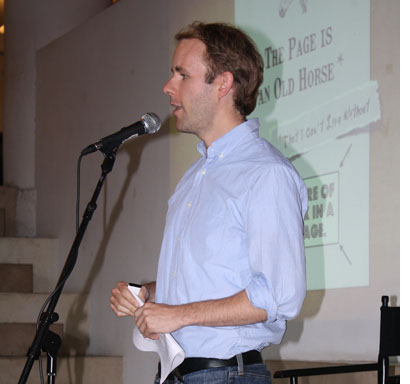Reif Larsen Maps Out the Future

PHOTOS COURTESY OF POWERHOUSE BOOKS
Reif Larsen’s The Selected Works of T.S. Spivet (Penguin Press, 2009) is very much about maps. Narrated by 12-year-old genius cartographer, T.S. Spivet, the book introduces us to a world in which everything–from geography to the method by which a sister shucks corn to the onset of male pattern baldness–is meticulously charted and displayed, complete with musings, diagrams, and other assorted marginalia, alongside the text of the story. However, according to Larsen, since the book’s release, people have taken great pains to inform him that what his protagonist does is not technically mapping. No matter: “What’s interesting to me,” said Larsen, is not the strict definition of the word cartographer but rather, “How we attempt to represent the world around us in two-dimensional space in a way that inherently simplifies and selects from the very rich, complex, dirty world around us, and makes meaning on a page. So, for me, a writer is a kind of mapper.”
He added: “I wasn’t setting out to write a crazy formatted, illustrated book.” Finding the character of T.S. was, “Like everything in this book, a slow process of discovery.” In the original version, the main character was a 50-year-old drunk in a Parisian prison (“That was a terrible book,” the author said). In the published version, T.S., a precocious Montana middle-schooler poised on the cusp of adolescence and cartographic renown finds solace from recent emotional trauma and the often chaotic and confusing adult world around him in the creation of his maps: “A map does not just chart, it unlocks and formulates meaning; it formulates bridges between here and there.”
Last week, at the party celebrating the paperback release of The Selected Works of T.S. Spivet at the Powerhouse Arena in Dumbo, Brooklyn (pictured above), Larsen spoke about how his vision fit in to the publishing industry’s recent experiments with technology. The e-book, he warned, could too easily allow the design and interface of the novel to overwhelm its content. This, he said, is a mistake–content, rather than form, must always be the primary concern. But, he admitted, “Texts are inherently limited.” Just like a map, they provide us with a set amount of information, to be interpreted as the viewer sees fit. In both cases, he explained, there will always be disconnect between that which is being represented and the way it appears on the page (or screen). The real value of both objects is in that middle space: “The distance between the map and the territory allowed us breathing room to figure out where we stood.”






